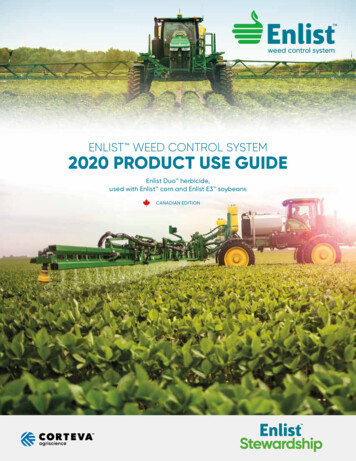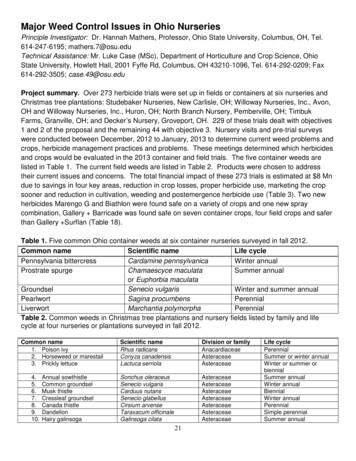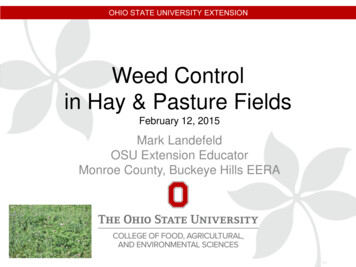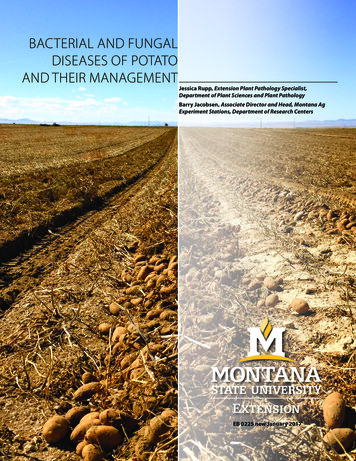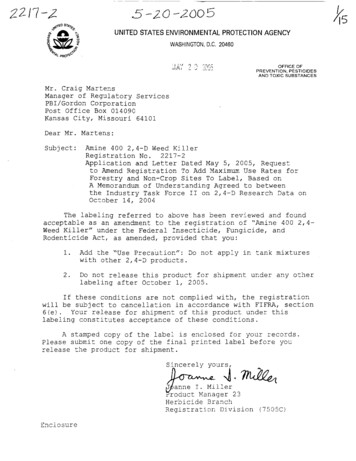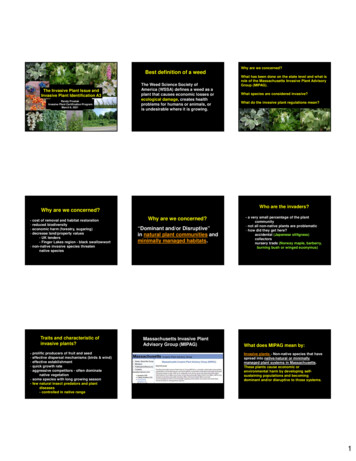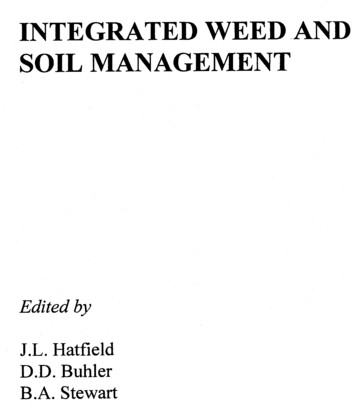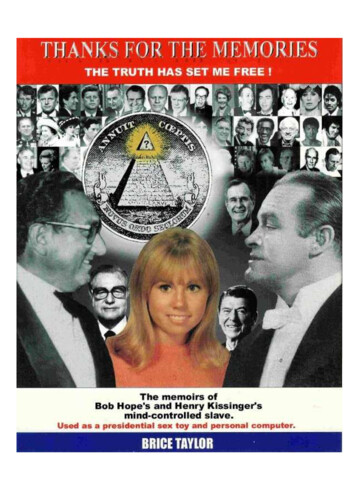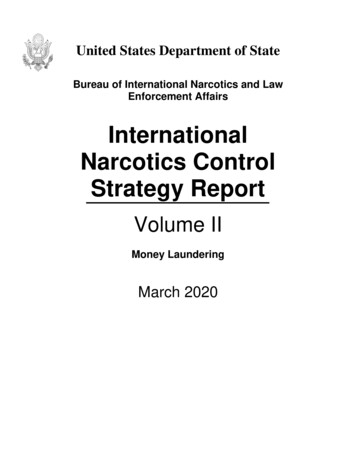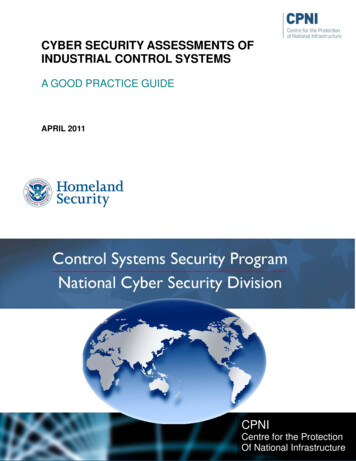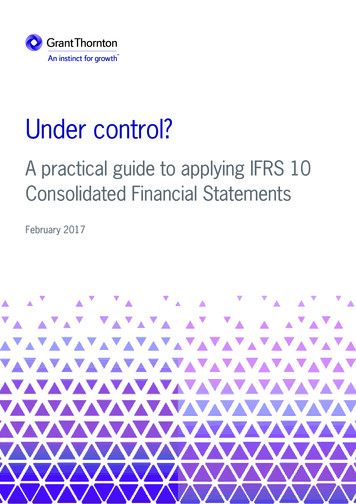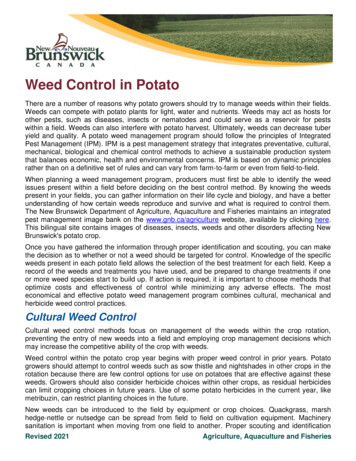
Transcription
Weed Control in PotatoThere are a number of reasons why potato growers should try to manage weeds within their fields.Weeds can compete with potato plants for light, water and nutrients. Weeds may act as hosts forother pests, such as diseases, insects or nematodes and could serve as a reservoir for pestswithin a field. Weeds can also interfere with potato harvest. Ultimately, weeds can decrease tuberyield and quality. A potato weed management program should follow the principles of IntegratedPest Management (IPM). IPM is a pest management strategy that integrates preventative, cultural,mechanical, biological and chemical control methods to achieve a sustainable production systemthat balances economic, health and environmental concerns. IPM is based on dynamic principlesrather than on a definitive set of rules and can vary from farm-to-farm or even from field-to-field.When planning a weed management program, producers must first be able to identify the weedissues present within a field before deciding on the best control method. By knowing the weedspresent in your fields, you can gather information on their life cycle and biology, and have a betterunderstanding of how certain weeds reproduce and survive and what is required to control them.The New Brunswick Department of Agriculture, Aquaculture and Fisheries maintains an integratedpest management image bank on the www.gnb.ca/agriculture website, available by clicking here.This bilingual site contains images of diseases, insects, weeds and other disorders affecting NewBrunswick's potato crop.Once you have gathered the information through proper identification and scouting, you can makethe decision as to whether or not a weed should be targeted for control. Knowledge of the specificweeds present in each potato field allows the selection of the best treatment for each field. Keep arecord of the weeds and treatments you have used, and be prepared to change treatments if oneor more weed species start to build up. If action is required, it is important to choose methods thatoptimize costs and effectiveness of control while minimizing any adverse effects. The mosteconomical and effective potato weed management program combines cultural, mechanical andherbicide weed control practices.Cultural Weed ControlCultural weed control methods focus on management of the weeds within the crop rotation,preventing the entry of new weeds into a field and employing crop management decisions whichmay increase the competitive ability of the crop with weeds.Weed control within the potato crop year begins with proper weed control in prior years. Potatogrowers should attempt to control weeds such as sow thistle and nightshades in other crops in therotation because there are few control options for use on potatoes that are effective against theseweeds. Growers should also consider herbicide choices within other crops, as residual herbicidescan limit cropping choices in future years. Use of some potato herbicides in the current year, likemetribuzin, can restrict planting choices in the future.New weeds can be introduced to the field by equipment or crop choices. Quackgrass, marshhedge-nettle or nutsedge can be spread from field to field on cultivation equipment. Machinerysanitation is important when moving from one field to another. Proper scouting and identificationRevised 2021Agriculture, Aquaculture and Fisheries
can help determine if new weed species are present. Ideally, escaped weeds should not beallowed to set seed.Potato cultivars that develop and maintain a dense canopy can be competitive with weeds. Cropuniformity and density is determined by the variety and seed spacing. Plant misses as a result ofpoor quality seed, poor seed cutting, planting conditions or a malfunctioning planter will reducecrop density and competitiveness with weeds. It is important that the planter be operatingefficiently to produce a uniform competitive plant stand. Early closure of the rows will shade outpotential weed issues, although other disease and insect management strategies should also beconsidered.Mechanical Weed ControlMechanical weed control is an effective tool for controlling annual weeds. If performed under thewrong conditions, tillage can have a negative effect on the efficiency of harvesting operations, yieldand quality. Hilling is the only post planting tillage operation necessary in the production ofpotatoes. The main objective of hilling is to provide sufficient soil for tuber set and development. Aproper hill will also prevent greening, minimize infection with late blight, minimize frost damage andfacilitate harvest.Pre-plant tillage can be used to control early season weeds. A shallow cultivation of the field 2-3days before potatoes emerge with a finger weeder, cultivators set to work shallow, or drag chainscan provide control of small emerged annual broadleaf weeds and grasses. Some control ofperennial weeds will be provided but these are more difficult to control. Addition of a between-therow cultivation, after crop emergence, will give control of weeds present. Subsequent hillingoperations will give further control of weeds. Set equipment properly to control weeds between therow and to bury weeds in the row with soil. Some control of established perennial weeds will beobtained but the equipment, if not properly cleaned, may also spread weeds to clean fields.Herbicide Weed ControlA number of herbicides are recommended for use in potatoes. Excellent weed control can beachieved if the spray program is planned in advance and is based on knowledge of eachproduction field. Herbicides must be used responsibly and judiciously. They are just onecomponent of an integrated weed management plan. Potatoes emerge approximately 15 to 30days after planting. A significant number of weeds can germinate in this time period. Cultivationand hilling will disturb the herbicide treated soil allowing weeds to germinate. If hilling is performedjust prior to emergence of potatoes, then a pre-emergent herbicide may not be required. Anapplication of a non-selective herbicide just prior to emergence of potatoes will control annualweeds and set back perennial weeds. Burn-off herbicides are not affected by tillage operations.If you start with a pre-emergence (PRE) herbicide treatment, you can apply post-emergence(POST) herbicide treatments later if necessary. If you ignore the possibility of PRE treatments andrely only on a POST treatment you have no other options if that treatment fails to give satisfactoryweed control. An integrated option for weed control is the use of herbicide bands over the potatorows with mechanical weed control between the hills. A fact sheet outlining this method of weedcontrol is available at this ments/BandedPesticidePotatoes.pdfAgriculture, Aquaculture and Fisheries
Herbicide NotesDo not use a herbicide more than once or apply an additional herbicide during the growing seasonunless split or combination treatments are registered. Supply companies sell products with differentconcentrations of the same herbicide. Over the years, some companies have changed theconcentration of active ingredient in a product. Various concentrations of glyphosate, linuron,metribuzin, EPTC and other herbicides are available, so refer to the specific product label for eachherbicide to verify correct application rates are used for these products. Always read and followlabel directions for every pesticide application. Pesticides approved for use in Canada may nothave similar approvals in all export markets. Always check with your processor or buyer to makesure products used are acceptable within their markets.CLETHODIM (Select, Centurion, Arrow and others) is a systemic post-emergence herbicidewith uptake primarily through the leaves. Clethodim should be used at all times in a tank-mix withthe adjuvant Amigo or X-Act. Apply clethodim when the annual grasses are in the 2 to 6 leaf stage.Most effective control is achieved if the application is made prior to tillering when annual grassesare small and actively growing. Most effective quackgrass control results are achieved whenapplication is made at the 3 to 5 leaf stage, when the canopy is uniform and actively growing.Clethodim will be less effective when plants are stressed by lack of moisture, excessive moisture,low temperature and/or very low relative humidity. Potatoes are tolerant to clethodim at all growthstages. Do not apply if rainfall is expected within 1 hour of application. Thorough coverage of theleaf foliage is necessary for consistent grass control. The time for complete control is normally 7 to21 days after application depending on growing conditions and crop competition.DIMETHENAMID-P (Frontier Max) will control annual grasses, red root pigweed and Easternblack nightshade, including Group 2 and triazine resistant biotypes. Dimethenamid-p should beapplied as a pre-emergent application before weeds emerge and after potatoes have beenplanted. Do not apply before planting or onto emerged potatoes. The best time to apply is shortlyafter a hilling operation that was made just before potatoes emerge. In cold and wet growingconditions, dimethenamid-p application may result in delayed emergence or early season stuntingof potatoes. The application rate will depend on soil type and organic matter levels. Apply higherrates on fine textured or high organic matter soils and for heavier weed problems. Apply in aminimum of 100 litres of water per hectare, to ensure good coverage. Select proper nozzle andpressure to avoid spraying fine mist. For best results, use flat fan or flood jet nozzle. Rainfall isrequired to activate and move the herbicide into the soil zone. If dry conditions persist, a shallowcultivation or the use of a rotary hoe will move the chemical into moist soil and control weedescapes. If cultivation is necessary because of soil crusting or compaction, tillage should beshallow to minimize dilution of the herbicide. An eleven month interval is required before plantingrotational crops that are not registered for use with dimethenamid-p.EPTC (Eptam) is applied under low pressure (200 kPa) in 110-340 litres of water per hectare.EPTC can be used at the following times: 1) before planting, 2) at drag-off (a light cultivation beforepotatoes emerge) or 3) post emergence. Regardless of the timing of application, incorporation ofthe chemical is essential. Once trapped in the soil, a vapour forms when EPTC comes into contactwith moisture. This vapour acts to destroy germinating weed seeds and quackgrass rhizomes (ifrhizomes are 7.5 cm or less). A few broadleaf weeds, such as wild radish and wild mustard, are notcontrolled. Another herbicide application is usually required to control some weeds tolerant toEPTC. EPTC can also be tank mixed with metribuzin and applied before planting. Refer to thelabel for best application, tillage and weed control conditions for this herbicide.Agriculture, Aquaculture and Fisheries
FLUAZIFOP-P-BUTYL (Venture L) is applied post emergence to potatoes and weeds and willprovide control of many annual grasses and quackgrass. It does not control broadleaf weeds orsedges. Growth of grasses stops soon after application but destruction of the whole plant may takeseveral weeks. Fluazifop will be less effective when weeds are not growing rapidly due to stressfrom lack of moisture, excessive moisture, flooding, low-temperature and/or very low relativehumidity. For annual grass control, apply when the annual grasses have 2-5 leaves. Forquackgrass control, apply when the quackgrass has 3-5 leaves. Pre-plant tillage to fragmentquackgrass rhizomes improves control. Do not cultivate until 5 days after application. Do not applyif rainfall is expected within 2 hours of application. Fluazifop may also be tank mixed withmetribuzin formulations for early post emergent applications. Use a maximum volume of 300 L/ha.FOMESAFEN (Reflex) is applied pre-emergence to potatoes for the control of red-root pigweedand ragweed, plus suppression of lambs quarters. Fomesafen should be used to compliment otherherbicide applications and may help with weed resistance management. Apply at a rate of 1 L/haafter planting but before potato emergence. If weeds are emerged, include a recommended nonionic surfactant at 0.1% v/v. Apply in a minimum of 200 L water per hectare. Do not cultivate thesoil for 7 days following application. Do not apply to soils with more than 5% organic matter or tofine textured soils. Fomesafen may remain active in the soil for several months and residuespresent a potential for carry-over damage for certain crops. Do not apply fomesafen to any fieldmore than once every two years. The pre-harvest interval is 70 days.GLUFOSINATE AMMONIUM (Ignite): Apply glufosinate prior to ground crack (potato emergence).For best results, apply to emerged, actively growing weeds. Weeds emerging after application willnot be controlled. Apply in 110-330 litres of water per hectare. Glufosinate works as a contactherbicide, so uniform, thorough coverage improves control. In addition, application of the spray at a45o angle forward will result in better coverage. At cool temperatures (below 10 C), poor moistureand low humidity, speed of action may be reduced. Leave a 1 m buffer between edge of field andenvironmentally sensitive areas. Do not spray when winds exceed 16 km/hr if using open boomsprayers. For residual control of annual weeds, glufosinate may be tank mixed with Sencor 500 F.Do not apply if rainfall is expected within 4 hours of application. Do not use this product as avine desiccant before harvest.GLYPHOSATE (Roundup and others) is sold under many trade names and formulations, verifythe correct application rates with specific product labels. Glyphosate is used for perennial weedcontrol prior to planting potatoes. Glyphosate has no soil activity and therefore will not injure cropsplanted in the treated area. Glyphosate, when used after weed emergence but before ground crackwill control emerged weeds. Emerged potato plants will be injured and reduced yield may result.Apply in the spring or fall for quackgrass control. Quackgrass must be at least 20 cm in height (3 to4 leaf stage). Tillage prior to application will reduce control of quackgrass. Where tillage is desired,delay for 5 to 7 days after glyphosate application. Weed control with glyphosate is reduced if dirtyor hard water is used for application. The addition of ammonium sulfate to the spray mix isrecommended if glyphosate must be applied in hard water.LlNURON (Lorox L, Linuron) is applied pre-emergence as potato plants must be covered to avoidinjury. Potato seed should be 5 cm below the treated soil. Use sufficient water (300 L per ha) tocover the ground evenly. Abnormally heavy rainfall following application may cause crop injury.Sufficient moisture (usually 3-5 cm) is necessary after treatment to carry the chemical into the rootzone of germinating weeds; best results are obtained when this occurs within 7 to 10 days afterapplication. Avoid cultivation after application if possible. The high rate usually controls annualgrasses such as barnyard grass. Do not use on sand or coarse textured soils low in organic matter.Use the higher rate on clay soils and the lower rate on sandy soils.Agriculture, Aquaculture and Fisheries
METRIBUZIN (Sencor, Tricor, Squadron, Metrix) application pre-emergence to potatoes ispreferred. The higher rate is usually required to control annual grasses, to slow the growth ofquackgrass and for dense weed infestations. Use the low rate for broadleaf weed control only.Moisture is needed shortly after a pre-emergence application for improved weed control. Apply in100-300 L water/ha. Avoid overlapped applications that will increase dosages above thoserecommended.Pre-emergence application (planting to ground crack) of metribuzin is preferred. However,where it is not possible to spray before crop emergence, metribuzin can be applied early postemergence before weeds are 4 cm high and before first emerged potato tops are 10 cm high. Thistreatment may cause temporary yellowing and/or leaf burn, especially when the crop is under thestress of poor growing conditions. Do not use when plants are under stress, such as cool, wet,cloudy weather conditions or very dry soil conditions. Do not use on muck soil. Not all potatovarieties have been tested for tolerance to metribuzin. Some potato varieties (such as earlymaturing, red-skinned, Atlantic, Eramosa, Shepody) can be sensitive to and injured by anapplication of metribuzin (such as yellowing/necrosis of leaf veins or leaf margins, stunting, andpossible delay in harvest). First use of metribuzin on a potato variety must be limited to a small testarea to ensure risk or level of potential injury is acceptable to the grower prior to adoption as ageneral field practice. Sensitivity to or injury after a postemergent application of metribuzin istypically visible in the test area within 5 days after application. Do not apply metribuzin early postemergence on Shepody, Tobique, Belleisle, Sante, Tolaas, Atlantic, Eramosa, red-skinnedvarieties and potatoes grown for early market. Superior and Norchip appear to be sensitive tometribuzin applied post-emergence. Use only pre-emergence on Shepody cultivars. Consult yourchemical dealer or seed supplier for information on the tolerance of newly released varieties.Under New Brunswick conditions, a few early post-emergence applications have occasionallyreduced vine growth sufficiently to retard bulking and possibly to reduce yield. However, underthese situations, the use of metribuzin applied early post-emergence to potatoes could be betterthan abandoning the crop to weeds, such as barnyard grass, weeds which are difficult to control bycultivation. If insufficient metribuzin was used pre-emergence, an additional early post-emergencetreatment for annual grass may be applied. Do not apply more than a total of 1.1 kg activemetribuzin per hectare in a growing season. Fall-seeded cover crops and certain vegetables suchas cole crops, seeded the following spring, can be injured from metribuzin residue in the soil.METRIBUZIN/S-METOLACHLOR (Boundary LQD) is a commercial pre-mix of two activeingredients. The rate of metribuzin in Boundary LQD is lower than the typical metribuzin rates usedin potato production, so growers may need supplemental weed control when using this product.Boundary LQD is applied before potato emergence. For additional information, follow therestrictions and recommendations from metribuzin and s-metolachlor sections of the guide. Do notapply at ground crack or if potatoes are emerged.METRIBUZIN/S-METOLACHLOR (Strim MTZ) is a commercial pre-mix of two active ingredients.The recommended rate of metribuzin in Strim MTZ is similar to the typical metribuzin rates used inpotato production. Strim MTZ is applied before potato emergence. For additional information,follow the restrictions and recommendations from metribuzin and s-metolachlor sections of theguide. Do not apply at ground crack or if potatoes are emerged.METRIBUZIN/SULFENTRAZONE (Sencor STZ) is a mixture of two active ingredients, to helpcontrol triazine resistant weeds and other hard to control species. Follow all restrictions from theSencor label. Applications must be made before potato emergence to avoid crop injury. Aminimum of 2.5 cm (1 inch) of soil must cover emerging potato shoots at application. Injury mayoccur if potato seed pieces are germinating or if they are located near the soil surface. Avoid soilAgriculture, Aquaculture and Fisheries
disturbance, including hilling, after application. Sencor STZ requires rainfall to activate, ideallywithin 10-14 days following application. A range of application rates are listed on the label. Usehigher rates for longer season potatoes, heavy weed infestations or in soils with a pH less than 7.0and organic matter greater than
Pest Management (IPM). IPM is a pest management strategy that integrates preventative, cultural, mechanical, biological and chemical control methods to achieve a sustainable production system that balances economic, health and environmental concerns. IPM is based on dynamic principles
